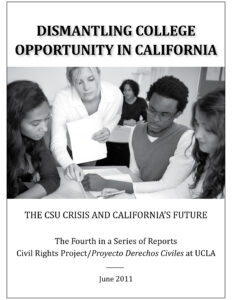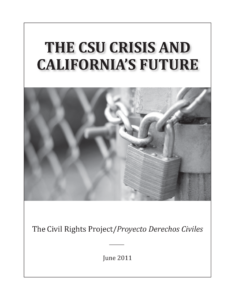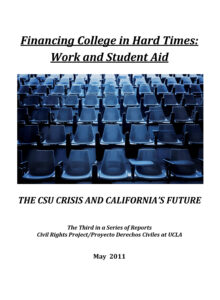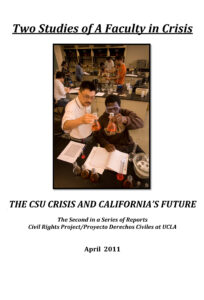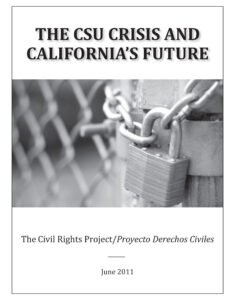PART ONE analyzes the impact of fiscal cutbacks on opportunity for higher education in the California State University system from a variety of perspectives.
Squeezed from all Sides examines the devastating impact state budget cuts and the faltering economy are having on students at one of the California State University system’s largest campuses with a student body that mirrors the statewide enrollment composition of the nation’s largest system of public universities. The report surveys students at CSU, Northridge and shows that they are struggling to finish college as tuition soars, class offerings shrink, and the families are devastated by the economic turndown, the housing crisis, and the very high levels of joblessness and underemployment. More than half of students reported that their families are relying on them more for financial help, placing huge burdens on students struggling to finish school.
Foreword
California long enjoyed rapid growth, abundant jobs, and expanding college opportunity—key elements of the California dream. Now the state is struggling to recover from its worst economic crisis in generations, a demographic slowdown, a devastating collapse of the wealth of the state’s families from the housing crisis, and severe cutbacks in higher education. California’s students are being asked to pay much more to get less. There can be no doubt that these are extraordinary times and if California is to emerge from its worst fiscal crisis in modern times, it will require sacrifice on everyone’s part. Yet, in spite of a lot of discussion about the budget crisis, there has been too little analysis of the consequences of the budget cuts and far too little information on how the cuts have affected the lives and prospects of our young people trying to finish college and prepare for a future.
A recent report from the non-partisan Public Policy Institute of California predicts that the state will be short one million college graduates needed in 2025 to fill the jobs that require a BA. Another recent study from the National Center for Public Policy and Higher Education projected that by 2020 California would begin to see an 11% reduction in its per capita earnings if the state was not able to immediately increase the number of college graduates. Higher education is the economic engine of the state and that engine produces jobs, and it is in this context that California is slashing the budgets of its colleges and universities. No institution is more central in producing the college degrees that the state so desperately needs than the California State University (CSU), the nation’s largest system of public universities.
If the colleges remain full, and students who can manage somehow pay the rapidly rising tuition, it is easy to assume that things are working out. But at what cost to the state? If students take significantly longer to graduate and their education must be subsidized for 25% or more time, are there truly any savings to the state? If these young people are delayed in entering the job force because they are short courses they need to graduate, how much does it cost the state in foregone tax revenues? Will the state accommodate the rising demand for higher education? This research went to the students on one of the largest CSU campuses to ask them how the changes are affecting their lives. What they told us shows that the challenges they face are severely limiting their opportunities and taking years out of their productive lives; these challenges are putting great stress upon families that are already disrupted by the loss of jobs and income. Too many students are helping support their families, who can no longer help them. Latino and black students are especially hard hit but many white students and their families face all of these problems as well.
Most students are determined to keep going, because they know the consequences of not finishing college, especially in a state where the decent middle class jobs for people without degrees are shrinking away. But students are also facing an alarmingly high level of stress. As we face the prospects of making a very bad situation still worse, it is important for Californians to listen seriously to the voices of California’s students, and to weigh the urgent question: at what cost are we shifting the burden to these young people?
We understand very well that the state of California faces a terrible financial crisis that will not be resolved without significant sacrifice. We know that the poor, the elderly, those with physical and mental illnesses and many others are suffering badly and that critical basic services are being cut. But California is a state with many resources that have not been tapped and we have broken the pact that the state has historically made with the young—to educate them so that they can compete with the rest of the country and the world, and so that each generation can reach beyond the boundaries of the prior one to build the state’s future. This generation is being asked to pay much more for much less and to do it in the worst economic situation since the Great Depression. Older generations that were offered excellent public higher education at a much lower price have now voted to offer this generation less for much higher costs, even while higher education has become much more crucial for the future of all Californians. The choices are grim. Either we develop the talent of our young people or we decline. There is no easy answer in this difficult time, but we all need to listen carefully to the struggling students who are the state’s future.
Read more about why we undertook these studies: THE CSU CRISIS AND CALIFORNIA’S FUTURE
For a brief summary of each paper in the series or to download the complete manuscript, see The CSU Crisis and California’s Future: Paper Titles, Authors and Abstracts.
In compliance with the UC Open Access Policy, this report has been made available on eScholarship:

